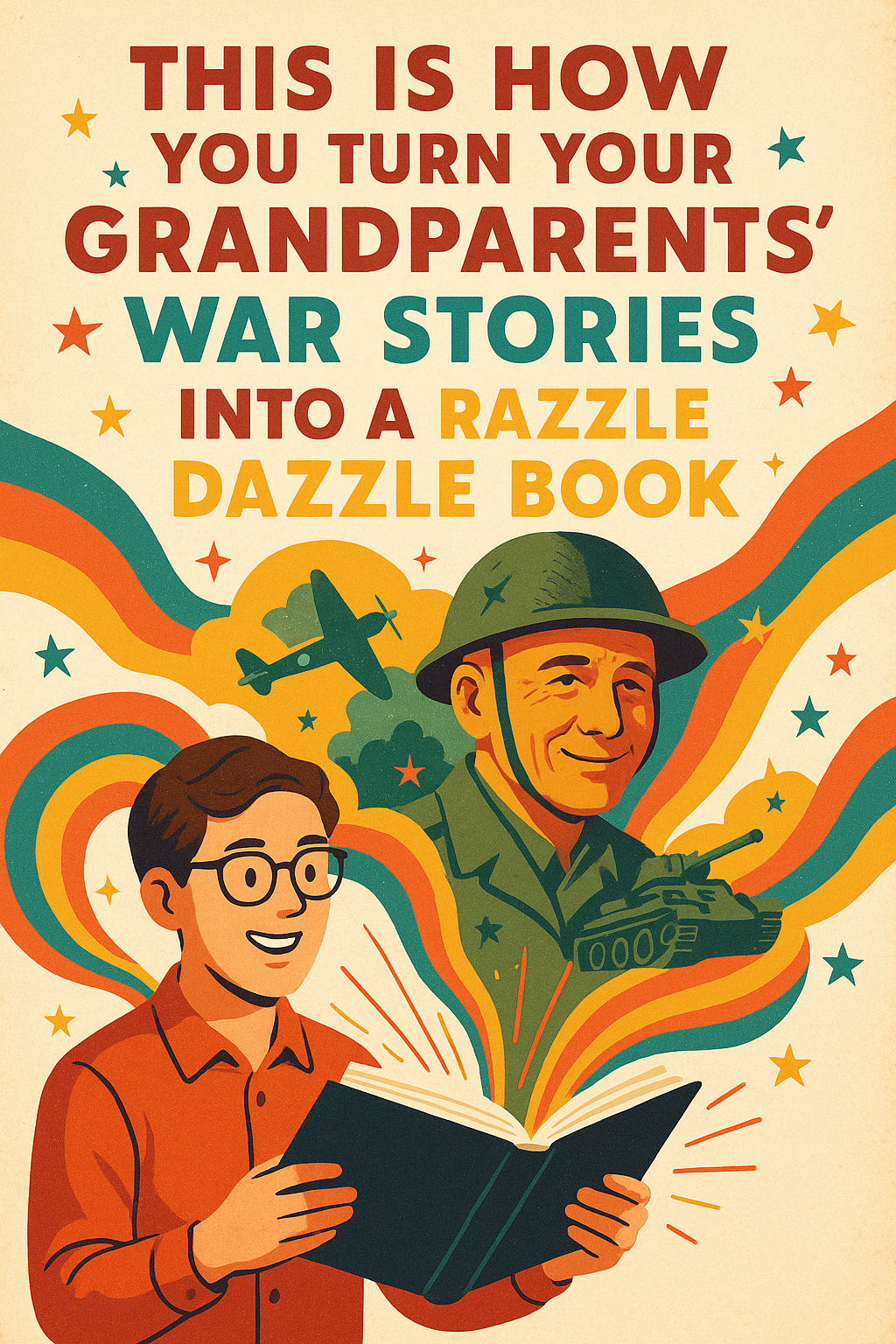If your grandparents ever shared stories about life during wartime—whether from the front lines or the home front—you’ve likely been struck by the richness of their experiences. Their words hold weight, their memories are irreplaceable, and their journeys deserve to be honored.
Turning those stories into a razzle-dazzle book isn’t just about recording history—it’s about creating a living legacy that inspires future generations. With the support of professional ghostwriters or dedicated memoir ghostwriting experts, even the most unpolished recollections can be shaped into a heartfelt, unforgettable read.
This isn’t just about storytelling—it’s about heritage, family, and the rare magic of capturing a real human experience in print.
Here’s your step-by-step guide on how to turn your grandparent’s war stories into a razzle-dazzle book that’s worth its weight in memory, emotion, and timeless wisdom.
Step 1: Start With Conversations, Not Questions For Your Razzle-Dazzle Book
Too often, family stories are lost because no one asks at the right time. The first step is to sit down and talk—really talk—with your grandparents. But instead of firing off a list of questions, ease into the conversation.
Make it personal. Ask:
- “What was a typical day like during the war?”
- “Do you remember the moment you heard the war was over?”
- “What did you miss most while away from home?”
Record these chats (with their permission) so you can revisit the tone, emotion, and details. Remember, the voice of the story is just as important as the events themselves.
If you’re dealing with memory challenges or limited time, that’s where working with a ghostwriter for memoirs can help bridge the gap. Experienced writers know how to gently guide interviews while preserving the subject’s natural voice.
Step 2: Organize Memories by Theme, Not Chronology
Wartime memories often come in fragments—vivid scenes, not neat timelines. Rather than trying to force everything into strict order, look for themes:
- Courage under fire
- Homesickness
- Lost friendships
- Love letters and romance
- Humor in unexpected places
- Post-war adjustment
These themes can act as chapter anchors, allowing readers to travel with their grandparents through the emotional arc of the story rather than just dates and ranks.
Step 3: Fill in the Gaps with Research
Sometimes, memory fades. Or there are questions that can’t be answered anymore. That’s where supplemental research can elevate the story.
You can:
- Reference historical records or timelines to validate key events
- Visit military archives for unit or division details
- Find old letters, photos, or keepsakes
- Explore the social and political climate during the time
A professional from biography writing services will often help research these elements to ensure historical accuracy while enhancing the emotional impact.
When layered thoughtfully, these details add richness and context—making the narrative immersive and educational without sounding like a textbook.
Step 4: Capture the Voice, Not Just the Facts
The power of a memoir isn’t just in what happened—it’s in how it’s told. Was your grandfather funny and self-deprecating? Was your grandmother poetic and reflective? Keep those tones alive in the narrative.
This is where memoir ghostwriting shines. A skilled ghostwriter can translate rough anecdotes into polished prose while keeping the personality of the narrator intact.
Even grammar mistakes, quirky phrases, or accents can be used stylistically in dialogue to preserve the storyteller’s unique flavor.
Step 5: Decide on the Book Format and Tone
Now that you’ve got raw material, it’s time to shape it into a book. But what kind of book?
Memoir or Biography?
- Memoir focuses on personal experience and emotion.
- Biography may include broader life events with a more formal tone.
For most war stories, memoirs provide a more engaging and emotional read.
First Person or Third Person?
- First-person puts readers directly in your grandparent’s shoes.
- Third-person offers a more journalistic, reflective tone.
Whichever you choose, ensure it stays consistent throughout.
If you’re not confident in narrative structure or voice, hiring a ghostwriter for memoirs can ensure the story flows well while honoring its subject.
Step 6: Add Visual Elements for Emotional Impact
A memoir comes to life with photos, letters, medals, maps, or journal scans. These give context and emotional weight to the story. Don’t overdo it, but do include:
- A portrait photo near the introduction
- Military IDs or awards in relevant chapters
- Scanned letters or love notes (if appropriate)
- Maps or old clippings in an appendix
If you’re using biography writing services, they’ll often offer design layout and image integration as part of the publishing package.
Step 7: Edit, Edit, and Edit Again
Once you’ve compiled a draft, the real work begins. Editing is where stories evolve from raw material to literature.
Focus on:
- Eliminating repetition
- Maintaining narrative tension
- Correcting names, dates, and military terms
- Making sure the emotional arc is satisfying
Consider beta readers—family members or friends who can give honest feedback. Better yet, bring in a professional editor with experience in memoir ghostwriting to ensure clarity, pacing, and emotional consistency.
Step 8: Decide How to Publish
Now that you’ve created a masterpiece, how will it reach the world?
Private Heirloom
A professionally bound book printed in limited quantities for family and friends. Ideal for preserving legacy within the family.
Self-Published Memoir
Use platforms like Amazon KDP, IngramSpark, or BookBaby to reach a wider audience while maintaining creative control.
Commercial Publication
A more competitive route requires pitching to agents or publishers. If the story has national or historical relevance, this could be worth exploring.
Working with biography writing services like BookPlanets can help streamline the process from formatting to ISBN registration to distribution.
Step 9: Share the Story Beyond the Page
Once your book is live (or gifted), extend its reach:
- Host a book launch or family reading
- Share excerpts on social media with photos
- Submit your grandparent’s story to historical archives or museums
- Donate copies to local libraries or veteran organizations
Not only do you honor your family’s legacy—you inspire others to do the same.
Conclusion
Turning your grandparent’s war stories into a razzle-dazzle book isn’t just a creative project. It’s an act of love. A tribute. Preservation of lived history that might otherwise fade with time.
Whether you choose to write it yourself, partner with professional ghostwriters, or work closely with biography writing services, the journey is just as meaningful as the finished product.
And when you hold that final book in your hands, filled with courage, heartbreak, resilience, and humor, you’ll know: you’ve created something timeless.

